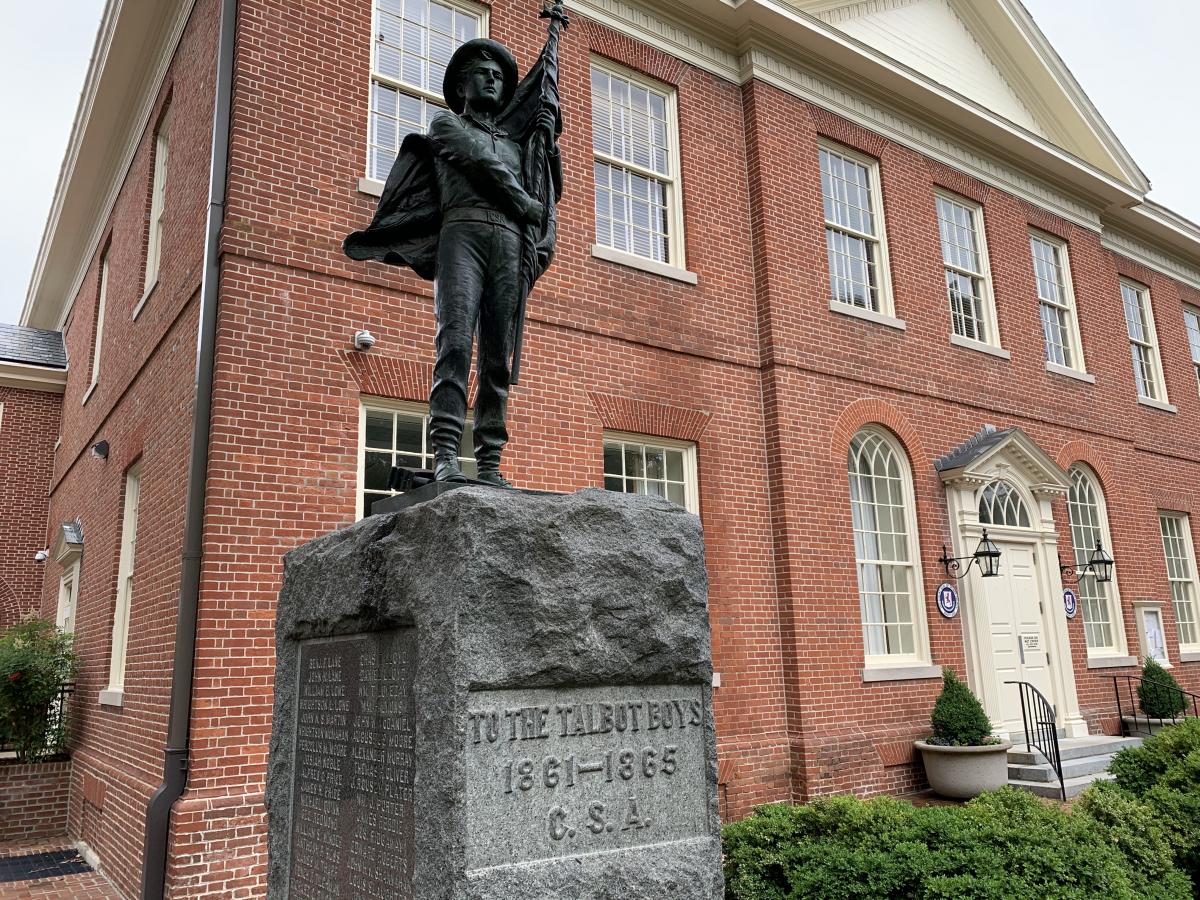A Confederate monument on the Talbot County courthouse lawn in Easton is racist and unconstitutional, said civil rights groups who filed a federal lawsuit Wednesday seeking to remove the Jim Crow-era statue.
The Maryland Office of the Public Defender and the Talbot County NAACP branch argue in the newly filed lawsuit that by keeping up the Confederate statue — a century-old monument to county residents who fought for the Confederacy during the American Civil War and the last Confederate monument on public land in Maryland — county officials are violating both state and federal laws.
The plaintiffs want the statue removed from the grounds of the Talbot County Courthouse.
The lawsuit represents the latest step in a years-long effort by activists to remove the statue from the courthouse grounds. After Talbot County Council members rejected a proposal to move the statue last year, rallies calling for the removal the Confederate monument continued. At a Wednesday press conference, the lawsuit’s plaintiffs said repeated rejections from county officials forced them to take legal action.
The ACLU of Maryland, alongside Crowell & Moring LLP, an international law firm based in Washington, D.C., is representing the plaintiffs in the case.
Dana Vickers Shelley, the executive director of the ACLU of Maryland, said Wednesday that both the county courthouse and the statue sit on the grounds of a former slave market.
“It is beyond time for this racist symbol of violence and oppression to be removed,” Vickers Shelley said.
“The Talbot Boys statue says just this: ‘In this building, white people are given priority over Black people;’ and ‘Justice for Black people means something different than what Justice means for white people means.’ To view it differently is to ignore objective fact,” the lawsuit reads.
The plaintiffs argue that the presence of the monument on the courthouse grounds violates the U.S. Constitution’s 14th amendment, which guarantees due process and equal protection of laws. The Talbot Boys statue’s location is “facially discriminatory,” the lawsuit reads.
“In short, the statue says symbolically no less clearly than were it emblazoned on the front entrance to the courthouse that Black people do not enjoy the ‘equal protection of the laws,’” the lawsuit reads.
The lawsuit notes that roughly 12.8% of Talbot County’s more than 37,000 residents are Black.
“That any government in the United States would continue to maintain the symbolism of white supremacy and promote a legacy of racial subjugation should shock the conscience,” the complaint reads. “That Talbot County does so on a courthouse lawn — a place of prominence that holds itself out as the seat of justice in the county; a place that county citizens pay for and maintain with tax dollars, including the tax dollars of its Black citizens who are overtly denigrated and humiliated by the statue — only compounds the unconscionability of the statue and illuminates its illegality.”
Kisha Petticolas, an assistant public defender in Talbot County and one of the plaintiffs in the case, said she has to walk past the statue on a daily basis for her work. Petticolas, who is Black, said the monument is a painful reminder of “hate, oppression and white supremacy” to both herself and her clients.
“My clients who are walking into the courthouse, hoping to be given a fair shot at justice, are walking onto a courthouse lawn that still celebrates the Confederacy,” Petticolas said. “It is beyond time for this statue to be removed from the courthouse grounds.”
In addition to violating the 14th Amendment, plaintiffs argue that county officials are violating other federal laws and Maryland’s own constitution by keeping the statue in place in front of the courthouse.
Richard Potter, the president of the Talbot County NAACP and a plaintiff, said his organization has been asking county council members to remove the statue since after the 2015 murder of nine Black people during Bible study by a white supremacist in Charleston, South Carolina.
That effort was rebuffed by council members, who have also rejected subsequent efforts. Potter noted that calls to remove the statue were revived after the murder of George Floyd last year, but even amid a wave of Confederate monument removals across the country, county council members voted 3-2 against removing the Talbot Boys statue.
“The council left us with no other choice but to take this action,” Potter said Wednesday. “We have waited long enough.”
In voting to keep the monument up last year, the council majority said the fate of the Talbot Boys statue should be decided by community members instead of the county government.
“This should be in the hands of the community, and not our hands,” Council Vice President Charles F. Callahan III (R), who voted to keep the statue in place, said at the time.
Council President Corey W. Pack (R) and Councilman Peter Lesher (D) voted to remove the monument, while the other Republicans on the council, Laura E. Price and Frank Divilio, voted to keep the statue.
Callahan did not immediately respond to a request for comment Wednesday.
Confederate monuments were removed from public grounds in Maryland and across the United States last year amid widespread protests against systemic racism and police brutality. In one of his final acts as Wicomico County executive before his death last year, Bob Culver (R) removed a Confederate marker in Salisbury.
During their 2021 legislative session, Maryland lawmakers voted to repeal “Maryland, My Maryland,” with its pro-Confederate lyrics, as the official state song.
Read the full complaint here:
1-mainBy Bennett Leckrone

